Report on Blending Generational Groups in the Modern Workforce
VerifiedAdded on 2021/06/18
|13
|3668
|22
Report
AI Summary
This report provides an executive summary on the challenges and opportunities presented by a multi-generational workforce. It highlights the differences in values, communication styles, and work ethics across generations, including Veterans, Baby Boomers, Gen X, Gen Y (Millennials), Gen Z, and Traditionalists. The report discusses the importance of understanding these differences to build effective teams, improve productivity, and foster a positive work environment. It emphasizes the need for managers to adapt their leadership styles, communication strategies, and training programs to accommodate the diverse needs of each generation. The report also touches upon the impact of technology, the importance of acknowledging diverse learning styles, and the value of creating a workplace where all generations feel respected and valued. Recommendations include fostering collaborative exchange, team-building exercises, and mentoring programs to bridge generational gaps and leverage the strengths of each generation. The report concludes by emphasizing that organizations that successfully address generational differences will be better positioned to succeed in today's dynamic business environment.
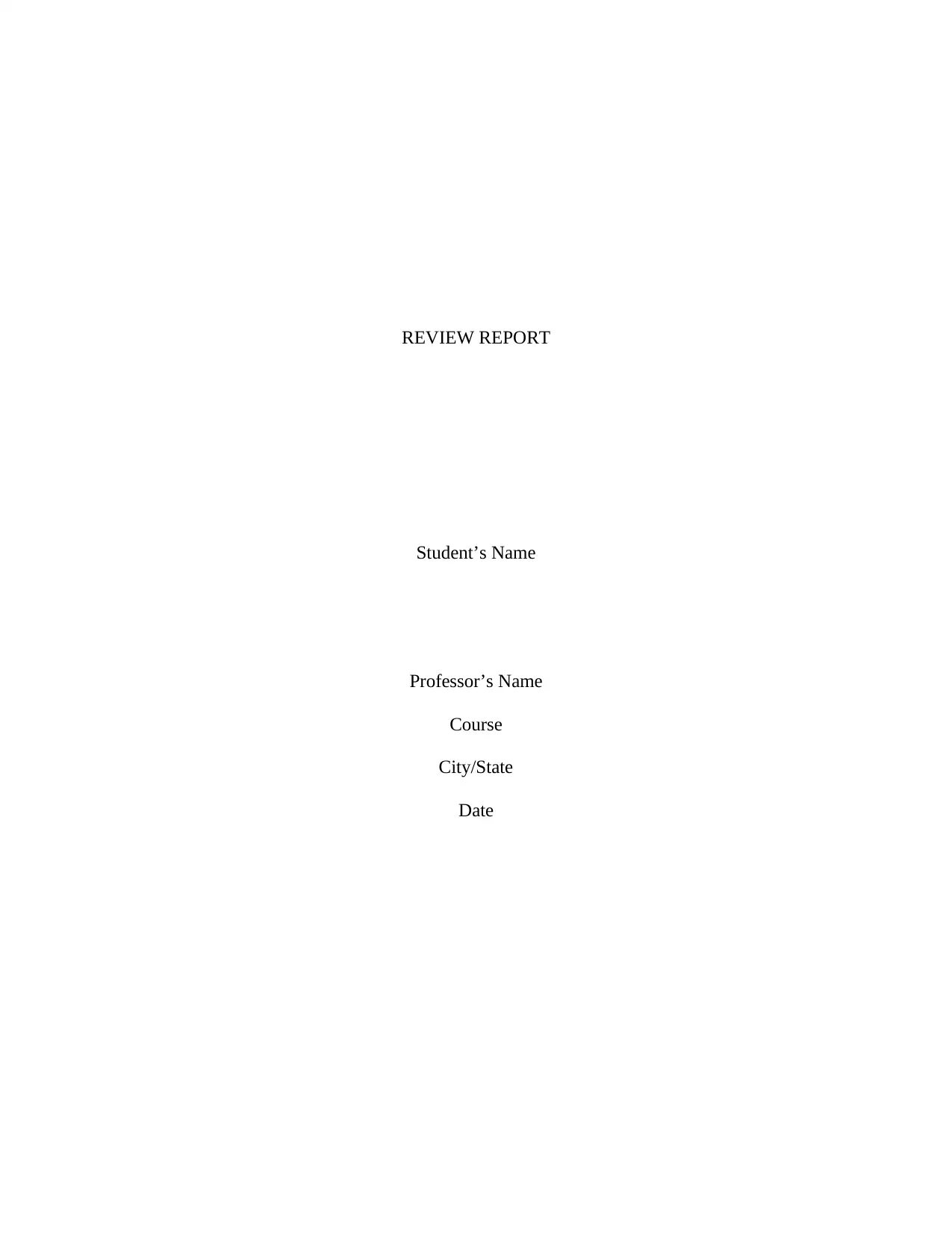
REVIEW REPORT
Student’s Name
Professor’s Name
Course
City/State
Date
Student’s Name
Professor’s Name
Course
City/State
Date
Paraphrase This Document
Need a fresh take? Get an instant paraphrase of this document with our AI Paraphraser
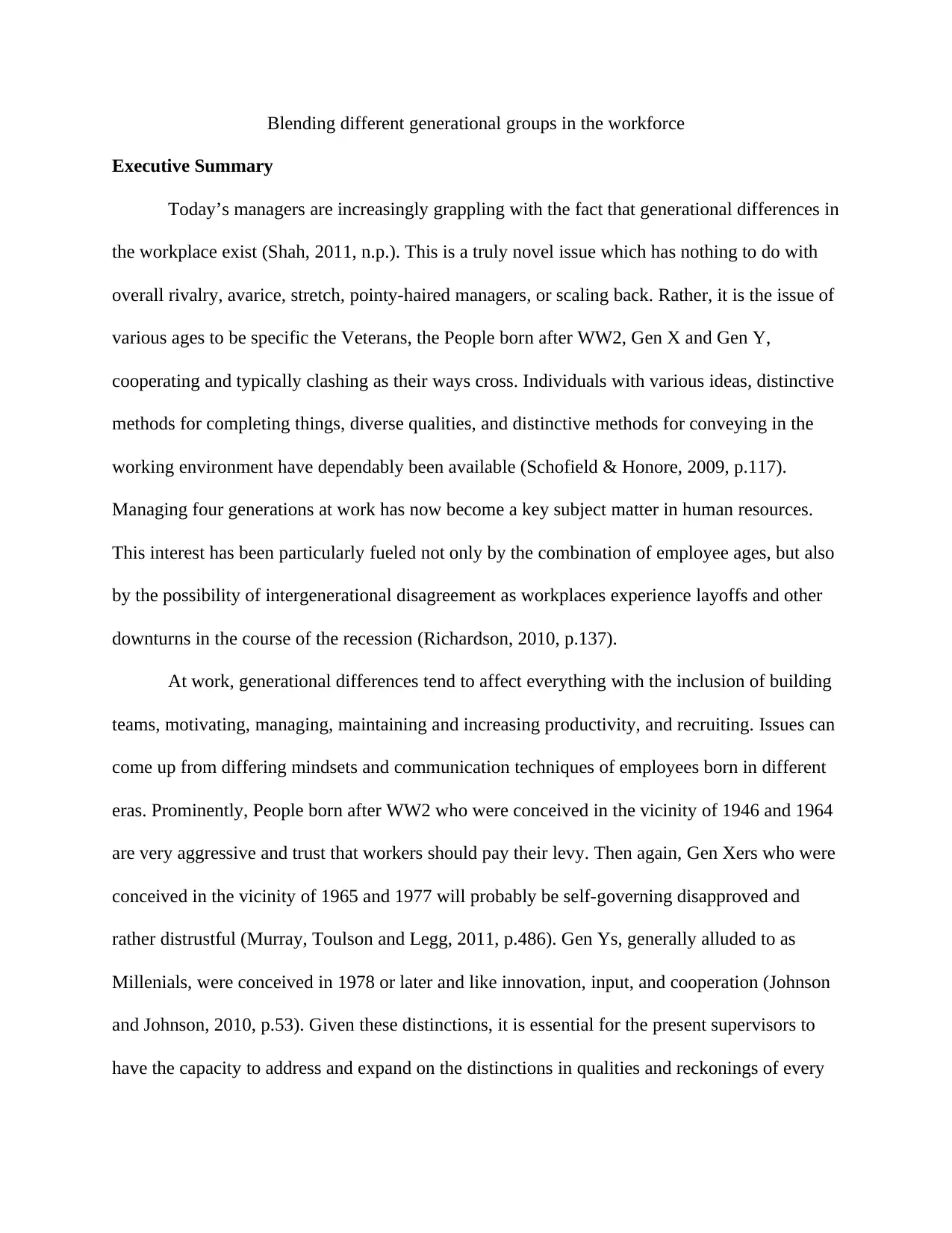
Blending different generational groups in the workforce
Executive Summary
Today’s managers are increasingly grappling with the fact that generational differences in
the workplace exist (Shah, 2011, n.p.). This is a truly novel issue which has nothing to do with
overall rivalry, avarice, stretch, pointy-haired managers, or scaling back. Rather, it is the issue of
various ages to be specific the Veterans, the People born after WW2, Gen X and Gen Y,
cooperating and typically clashing as their ways cross. Individuals with various ideas, distinctive
methods for completing things, diverse qualities, and distinctive methods for conveying in the
working environment have dependably been available (Schofield & Honore, 2009, p.117).
Managing four generations at work has now become a key subject matter in human resources.
This interest has been particularly fueled not only by the combination of employee ages, but also
by the possibility of intergenerational disagreement as workplaces experience layoffs and other
downturns in the course of the recession (Richardson, 2010, p.137).
At work, generational differences tend to affect everything with the inclusion of building
teams, motivating, managing, maintaining and increasing productivity, and recruiting. Issues can
come up from differing mindsets and communication techniques of employees born in different
eras. Prominently, People born after WW2 who were conceived in the vicinity of 1946 and 1964
are very aggressive and trust that workers should pay their levy. Then again, Gen Xers who were
conceived in the vicinity of 1965 and 1977 will probably be self-governing disapproved and
rather distrustful (Murray, Toulson and Legg, 2011, p.486). Gen Ys, generally alluded to as
Millenials, were conceived in 1978 or later and like innovation, input, and cooperation (Johnson
and Johnson, 2010, p.53). Given these distinctions, it is essential for the present supervisors to
have the capacity to address and expand on the distinctions in qualities and reckonings of every
Executive Summary
Today’s managers are increasingly grappling with the fact that generational differences in
the workplace exist (Shah, 2011, n.p.). This is a truly novel issue which has nothing to do with
overall rivalry, avarice, stretch, pointy-haired managers, or scaling back. Rather, it is the issue of
various ages to be specific the Veterans, the People born after WW2, Gen X and Gen Y,
cooperating and typically clashing as their ways cross. Individuals with various ideas, distinctive
methods for completing things, diverse qualities, and distinctive methods for conveying in the
working environment have dependably been available (Schofield & Honore, 2009, p.117).
Managing four generations at work has now become a key subject matter in human resources.
This interest has been particularly fueled not only by the combination of employee ages, but also
by the possibility of intergenerational disagreement as workplaces experience layoffs and other
downturns in the course of the recession (Richardson, 2010, p.137).
At work, generational differences tend to affect everything with the inclusion of building
teams, motivating, managing, maintaining and increasing productivity, and recruiting. Issues can
come up from differing mindsets and communication techniques of employees born in different
eras. Prominently, People born after WW2 who were conceived in the vicinity of 1946 and 1964
are very aggressive and trust that workers should pay their levy. Then again, Gen Xers who were
conceived in the vicinity of 1965 and 1977 will probably be self-governing disapproved and
rather distrustful (Murray, Toulson and Legg, 2011, p.486). Gen Ys, generally alluded to as
Millenials, were conceived in 1978 or later and like innovation, input, and cooperation (Johnson
and Johnson, 2010, p.53). Given these distinctions, it is essential for the present supervisors to
have the capacity to address and expand on the distinctions in qualities and reckonings of every
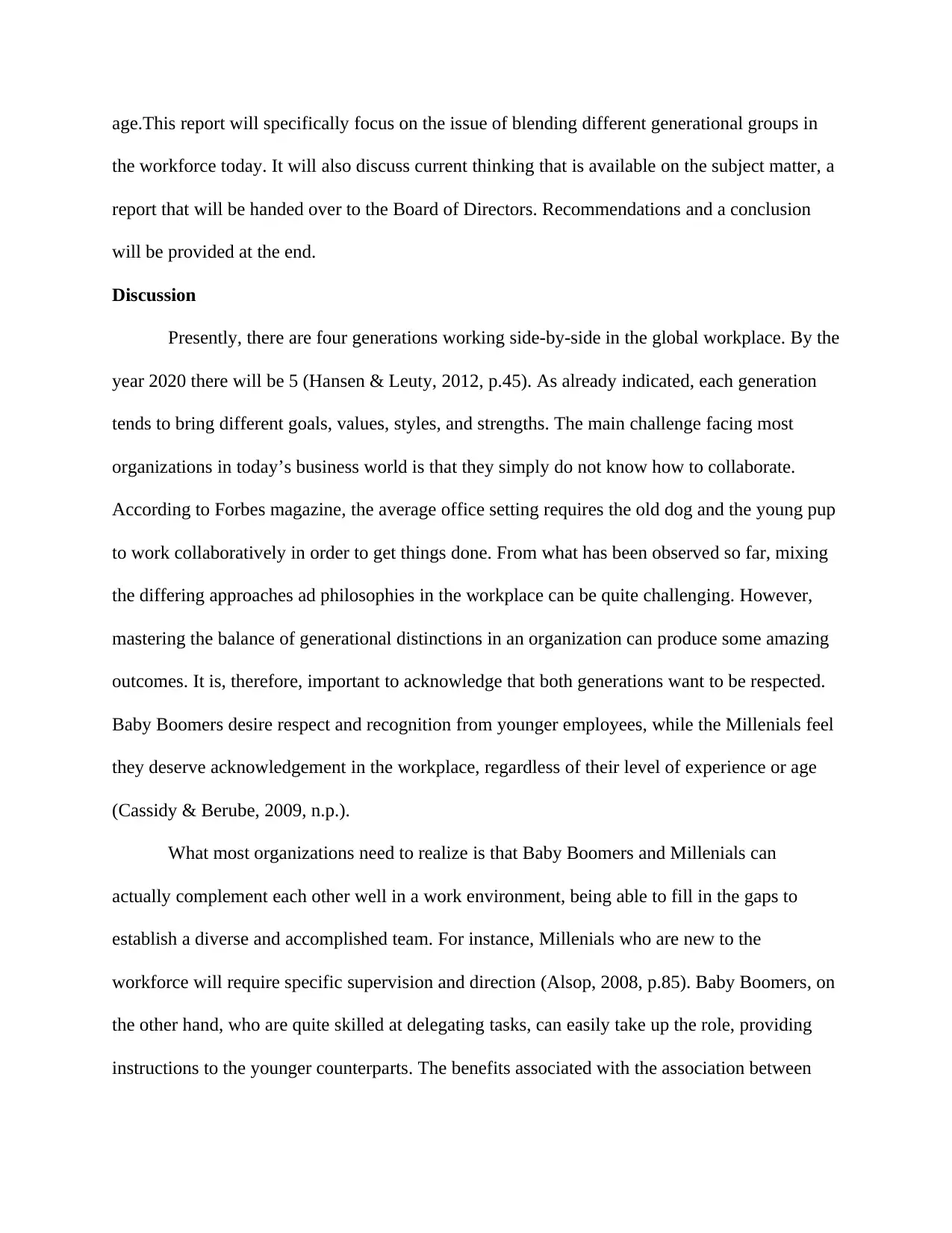
age.This report will specifically focus on the issue of blending different generational groups in
the workforce today. It will also discuss current thinking that is available on the subject matter, a
report that will be handed over to the Board of Directors. Recommendations and a conclusion
will be provided at the end.
Discussion
Presently, there are four generations working side-by-side in the global workplace. By the
year 2020 there will be 5 (Hansen & Leuty, 2012, p.45). As already indicated, each generation
tends to bring different goals, values, styles, and strengths. The main challenge facing most
organizations in today’s business world is that they simply do not know how to collaborate.
According to Forbes magazine, the average office setting requires the old dog and the young pup
to work collaboratively in order to get things done. From what has been observed so far, mixing
the differing approaches ad philosophies in the workplace can be quite challenging. However,
mastering the balance of generational distinctions in an organization can produce some amazing
outcomes. It is, therefore, important to acknowledge that both generations want to be respected.
Baby Boomers desire respect and recognition from younger employees, while the Millenials feel
they deserve acknowledgement in the workplace, regardless of their level of experience or age
(Cassidy & Berube, 2009, n.p.).
What most organizations need to realize is that Baby Boomers and Millenials can
actually complement each other well in a work environment, being able to fill in the gaps to
establish a diverse and accomplished team. For instance, Millenials who are new to the
workforce will require specific supervision and direction (Alsop, 2008, p.85). Baby Boomers, on
the other hand, who are quite skilled at delegating tasks, can easily take up the role, providing
instructions to the younger counterparts. The benefits associated with the association between
the workforce today. It will also discuss current thinking that is available on the subject matter, a
report that will be handed over to the Board of Directors. Recommendations and a conclusion
will be provided at the end.
Discussion
Presently, there are four generations working side-by-side in the global workplace. By the
year 2020 there will be 5 (Hansen & Leuty, 2012, p.45). As already indicated, each generation
tends to bring different goals, values, styles, and strengths. The main challenge facing most
organizations in today’s business world is that they simply do not know how to collaborate.
According to Forbes magazine, the average office setting requires the old dog and the young pup
to work collaboratively in order to get things done. From what has been observed so far, mixing
the differing approaches ad philosophies in the workplace can be quite challenging. However,
mastering the balance of generational distinctions in an organization can produce some amazing
outcomes. It is, therefore, important to acknowledge that both generations want to be respected.
Baby Boomers desire respect and recognition from younger employees, while the Millenials feel
they deserve acknowledgement in the workplace, regardless of their level of experience or age
(Cassidy & Berube, 2009, n.p.).
What most organizations need to realize is that Baby Boomers and Millenials can
actually complement each other well in a work environment, being able to fill in the gaps to
establish a diverse and accomplished team. For instance, Millenials who are new to the
workforce will require specific supervision and direction (Alsop, 2008, p.85). Baby Boomers, on
the other hand, who are quite skilled at delegating tasks, can easily take up the role, providing
instructions to the younger counterparts. The benefits associated with the association between
⊘ This is a preview!⊘
Do you want full access?
Subscribe today to unlock all pages.

Trusted by 1+ million students worldwide
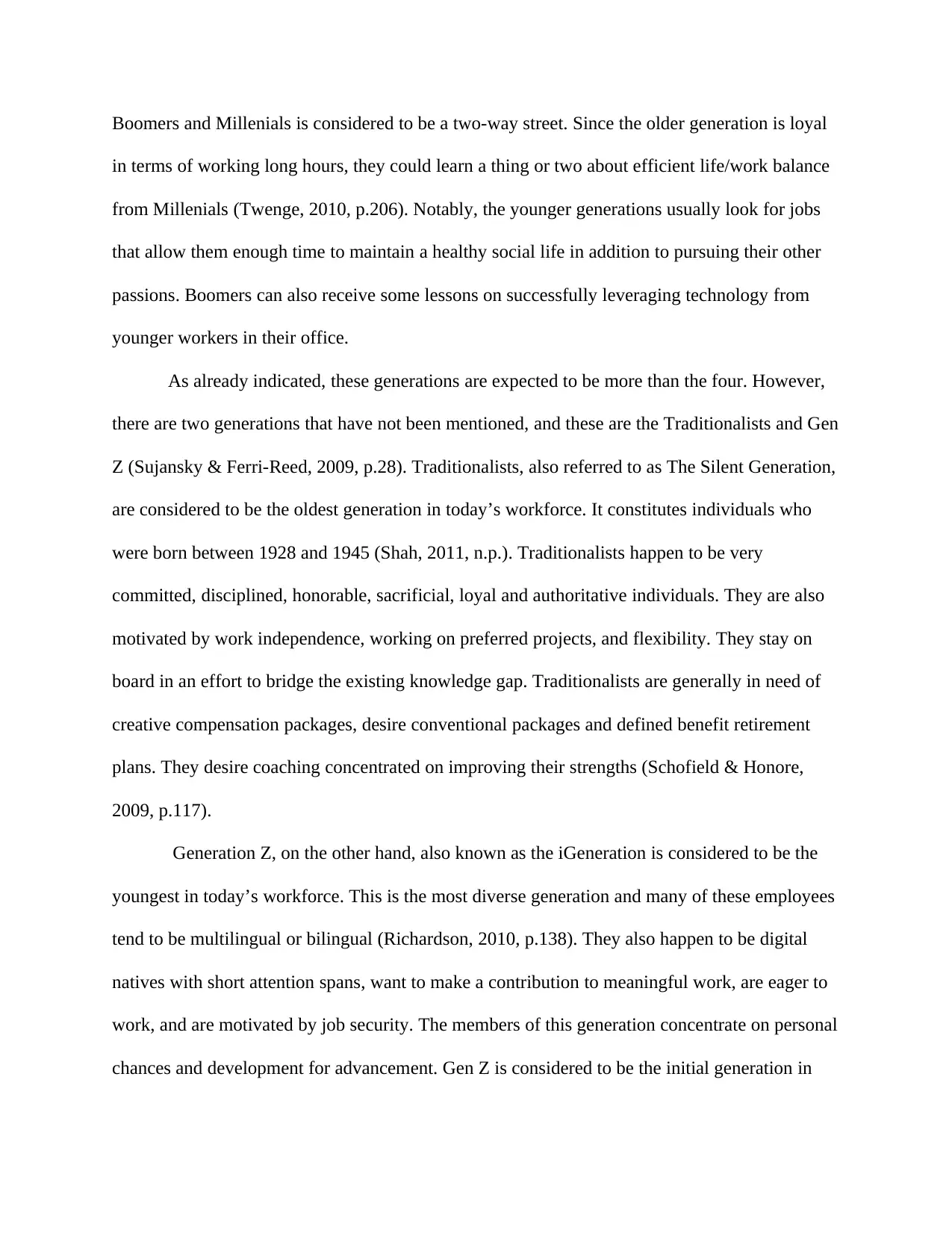
Boomers and Millenials is considered to be a two-way street. Since the older generation is loyal
in terms of working long hours, they could learn a thing or two about efficient life/work balance
from Millenials (Twenge, 2010, p.206). Notably, the younger generations usually look for jobs
that allow them enough time to maintain a healthy social life in addition to pursuing their other
passions. Boomers can also receive some lessons on successfully leveraging technology from
younger workers in their office.
As already indicated, these generations are expected to be more than the four. However,
there are two generations that have not been mentioned, and these are the Traditionalists and Gen
Z (Sujansky & Ferri-Reed, 2009, p.28). Traditionalists, also referred to as The Silent Generation,
are considered to be the oldest generation in today’s workforce. It constitutes individuals who
were born between 1928 and 1945 (Shah, 2011, n.p.). Traditionalists happen to be very
committed, disciplined, honorable, sacrificial, loyal and authoritative individuals. They are also
motivated by work independence, working on preferred projects, and flexibility. They stay on
board in an effort to bridge the existing knowledge gap. Traditionalists are generally in need of
creative compensation packages, desire conventional packages and defined benefit retirement
plans. They desire coaching concentrated on improving their strengths (Schofield & Honore,
2009, p.117).
Generation Z, on the other hand, also known as the iGeneration is considered to be the
youngest in today’s workforce. This is the most diverse generation and many of these employees
tend to be multilingual or bilingual (Richardson, 2010, p.138). They also happen to be digital
natives with short attention spans, want to make a contribution to meaningful work, are eager to
work, and are motivated by job security. The members of this generation concentrate on personal
chances and development for advancement. Gen Z is considered to be the initial generation in
in terms of working long hours, they could learn a thing or two about efficient life/work balance
from Millenials (Twenge, 2010, p.206). Notably, the younger generations usually look for jobs
that allow them enough time to maintain a healthy social life in addition to pursuing their other
passions. Boomers can also receive some lessons on successfully leveraging technology from
younger workers in their office.
As already indicated, these generations are expected to be more than the four. However,
there are two generations that have not been mentioned, and these are the Traditionalists and Gen
Z (Sujansky & Ferri-Reed, 2009, p.28). Traditionalists, also referred to as The Silent Generation,
are considered to be the oldest generation in today’s workforce. It constitutes individuals who
were born between 1928 and 1945 (Shah, 2011, n.p.). Traditionalists happen to be very
committed, disciplined, honorable, sacrificial, loyal and authoritative individuals. They are also
motivated by work independence, working on preferred projects, and flexibility. They stay on
board in an effort to bridge the existing knowledge gap. Traditionalists are generally in need of
creative compensation packages, desire conventional packages and defined benefit retirement
plans. They desire coaching concentrated on improving their strengths (Schofield & Honore,
2009, p.117).
Generation Z, on the other hand, also known as the iGeneration is considered to be the
youngest in today’s workforce. This is the most diverse generation and many of these employees
tend to be multilingual or bilingual (Richardson, 2010, p.138). They also happen to be digital
natives with short attention spans, want to make a contribution to meaningful work, are eager to
work, and are motivated by job security. The members of this generation concentrate on personal
chances and development for advancement. Gen Z is considered to be the initial generation in
Paraphrase This Document
Need a fresh take? Get an instant paraphrase of this document with our AI Paraphraser
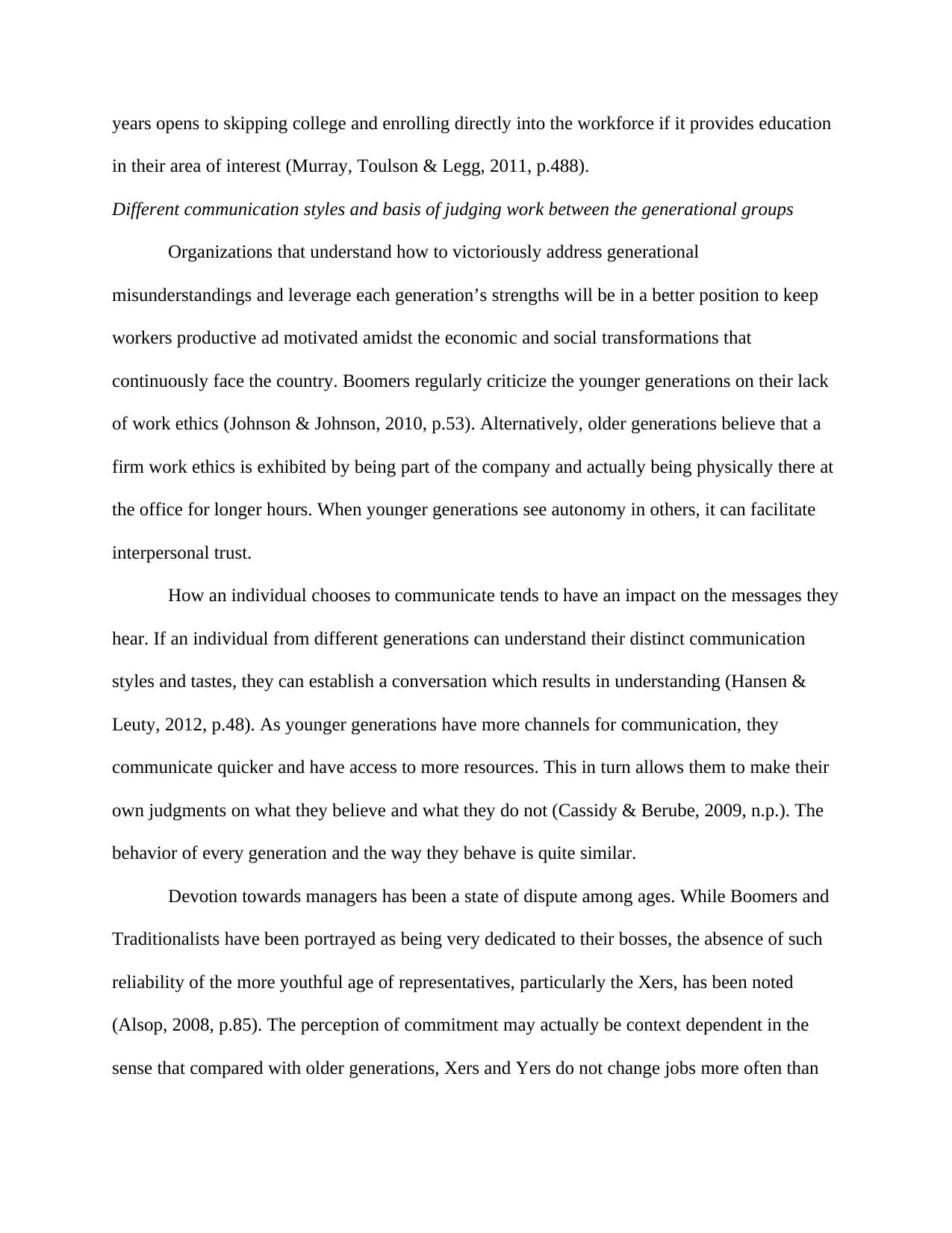
years opens to skipping college and enrolling directly into the workforce if it provides education
in their area of interest (Murray, Toulson & Legg, 2011, p.488).
Different communication styles and basis of judging work between the generational groups
Organizations that understand how to victoriously address generational
misunderstandings and leverage each generation’s strengths will be in a better position to keep
workers productive ad motivated amidst the economic and social transformations that
continuously face the country. Boomers regularly criticize the younger generations on their lack
of work ethics (Johnson & Johnson, 2010, p.53). Alternatively, older generations believe that a
firm work ethics is exhibited by being part of the company and actually being physically there at
the office for longer hours. When younger generations see autonomy in others, it can facilitate
interpersonal trust.
How an individual chooses to communicate tends to have an impact on the messages they
hear. If an individual from different generations can understand their distinct communication
styles and tastes, they can establish a conversation which results in understanding (Hansen &
Leuty, 2012, p.48). As younger generations have more channels for communication, they
communicate quicker and have access to more resources. This in turn allows them to make their
own judgments on what they believe and what they do not (Cassidy & Berube, 2009, n.p.). The
behavior of every generation and the way they behave is quite similar.
Devotion towards managers has been a state of dispute among ages. While Boomers and
Traditionalists have been portrayed as being very dedicated to their bosses, the absence of such
reliability of the more youthful age of representatives, particularly the Xers, has been noted
(Alsop, 2008, p.85). The perception of commitment may actually be context dependent in the
sense that compared with older generations, Xers and Yers do not change jobs more often than
in their area of interest (Murray, Toulson & Legg, 2011, p.488).
Different communication styles and basis of judging work between the generational groups
Organizations that understand how to victoriously address generational
misunderstandings and leverage each generation’s strengths will be in a better position to keep
workers productive ad motivated amidst the economic and social transformations that
continuously face the country. Boomers regularly criticize the younger generations on their lack
of work ethics (Johnson & Johnson, 2010, p.53). Alternatively, older generations believe that a
firm work ethics is exhibited by being part of the company and actually being physically there at
the office for longer hours. When younger generations see autonomy in others, it can facilitate
interpersonal trust.
How an individual chooses to communicate tends to have an impact on the messages they
hear. If an individual from different generations can understand their distinct communication
styles and tastes, they can establish a conversation which results in understanding (Hansen &
Leuty, 2012, p.48). As younger generations have more channels for communication, they
communicate quicker and have access to more resources. This in turn allows them to make their
own judgments on what they believe and what they do not (Cassidy & Berube, 2009, n.p.). The
behavior of every generation and the way they behave is quite similar.
Devotion towards managers has been a state of dispute among ages. While Boomers and
Traditionalists have been portrayed as being very dedicated to their bosses, the absence of such
reliability of the more youthful age of representatives, particularly the Xers, has been noted
(Alsop, 2008, p.85). The perception of commitment may actually be context dependent in the
sense that compared with older generations, Xers and Yers do not change jobs more often than
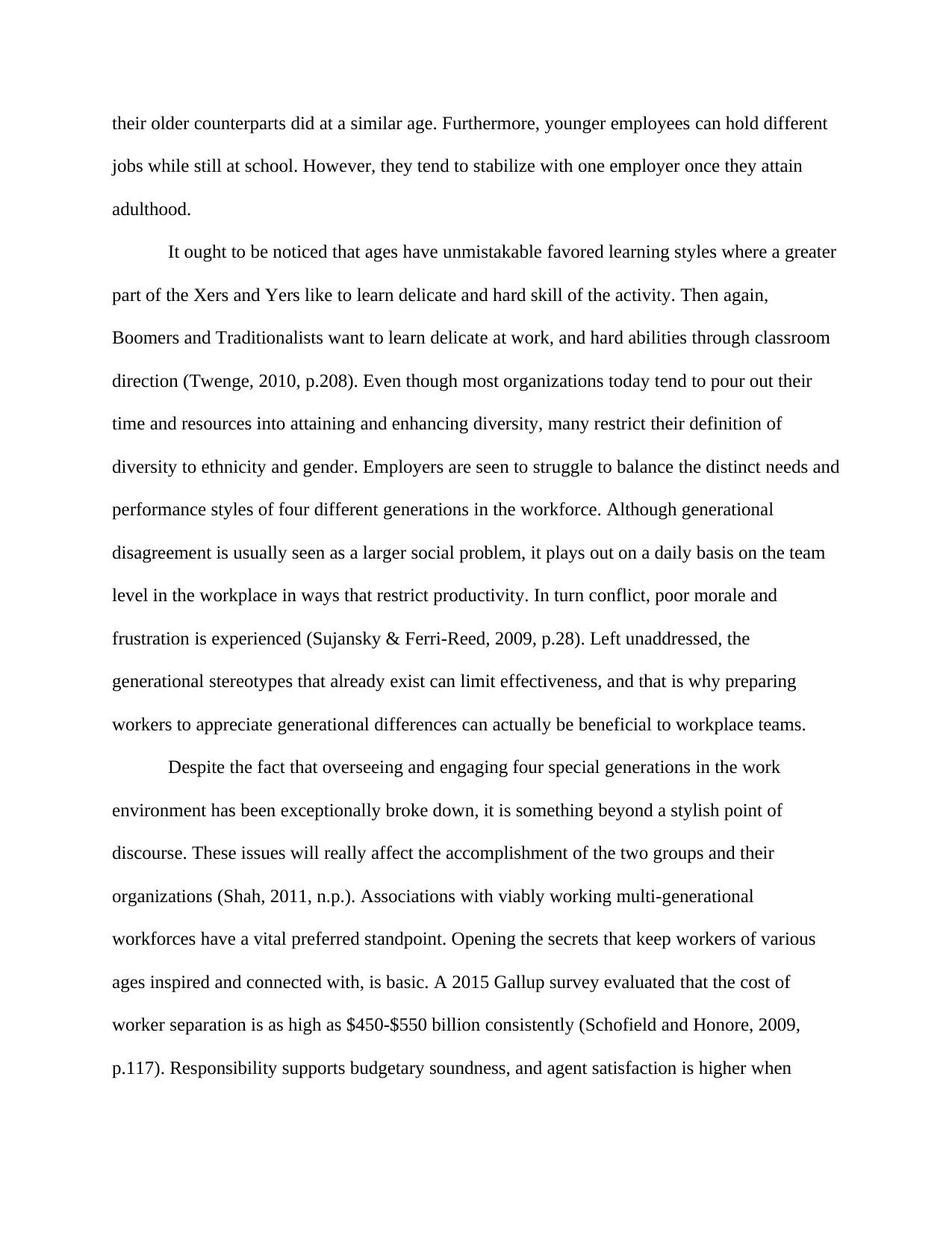
their older counterparts did at a similar age. Furthermore, younger employees can hold different
jobs while still at school. However, they tend to stabilize with one employer once they attain
adulthood.
It ought to be noticed that ages have unmistakable favored learning styles where a greater
part of the Xers and Yers like to learn delicate and hard skill of the activity. Then again,
Boomers and Traditionalists want to learn delicate at work, and hard abilities through classroom
direction (Twenge, 2010, p.208). Even though most organizations today tend to pour out their
time and resources into attaining and enhancing diversity, many restrict their definition of
diversity to ethnicity and gender. Employers are seen to struggle to balance the distinct needs and
performance styles of four different generations in the workforce. Although generational
disagreement is usually seen as a larger social problem, it plays out on a daily basis on the team
level in the workplace in ways that restrict productivity. In turn conflict, poor morale and
frustration is experienced (Sujansky & Ferri-Reed, 2009, p.28). Left unaddressed, the
generational stereotypes that already exist can limit effectiveness, and that is why preparing
workers to appreciate generational differences can actually be beneficial to workplace teams.
Despite the fact that overseeing and engaging four special generations in the work
environment has been exceptionally broke down, it is something beyond a stylish point of
discourse. These issues will really affect the accomplishment of the two groups and their
organizations (Shah, 2011, n.p.). Associations with viably working multi-generational
workforces have a vital preferred standpoint. Opening the secrets that keep workers of various
ages inspired and connected with, is basic. A 2015 Gallup survey evaluated that the cost of
worker separation is as high as $450-$550 billion consistently (Schofield and Honore, 2009,
p.117). Responsibility supports budgetary soundness, and agent satisfaction is higher when
jobs while still at school. However, they tend to stabilize with one employer once they attain
adulthood.
It ought to be noticed that ages have unmistakable favored learning styles where a greater
part of the Xers and Yers like to learn delicate and hard skill of the activity. Then again,
Boomers and Traditionalists want to learn delicate at work, and hard abilities through classroom
direction (Twenge, 2010, p.208). Even though most organizations today tend to pour out their
time and resources into attaining and enhancing diversity, many restrict their definition of
diversity to ethnicity and gender. Employers are seen to struggle to balance the distinct needs and
performance styles of four different generations in the workforce. Although generational
disagreement is usually seen as a larger social problem, it plays out on a daily basis on the team
level in the workplace in ways that restrict productivity. In turn conflict, poor morale and
frustration is experienced (Sujansky & Ferri-Reed, 2009, p.28). Left unaddressed, the
generational stereotypes that already exist can limit effectiveness, and that is why preparing
workers to appreciate generational differences can actually be beneficial to workplace teams.
Despite the fact that overseeing and engaging four special generations in the work
environment has been exceptionally broke down, it is something beyond a stylish point of
discourse. These issues will really affect the accomplishment of the two groups and their
organizations (Shah, 2011, n.p.). Associations with viably working multi-generational
workforces have a vital preferred standpoint. Opening the secrets that keep workers of various
ages inspired and connected with, is basic. A 2015 Gallup survey evaluated that the cost of
worker separation is as high as $450-$550 billion consistently (Schofield and Honore, 2009,
p.117). Responsibility supports budgetary soundness, and agent satisfaction is higher when
⊘ This is a preview!⊘
Do you want full access?
Subscribe today to unlock all pages.

Trusted by 1+ million students worldwide
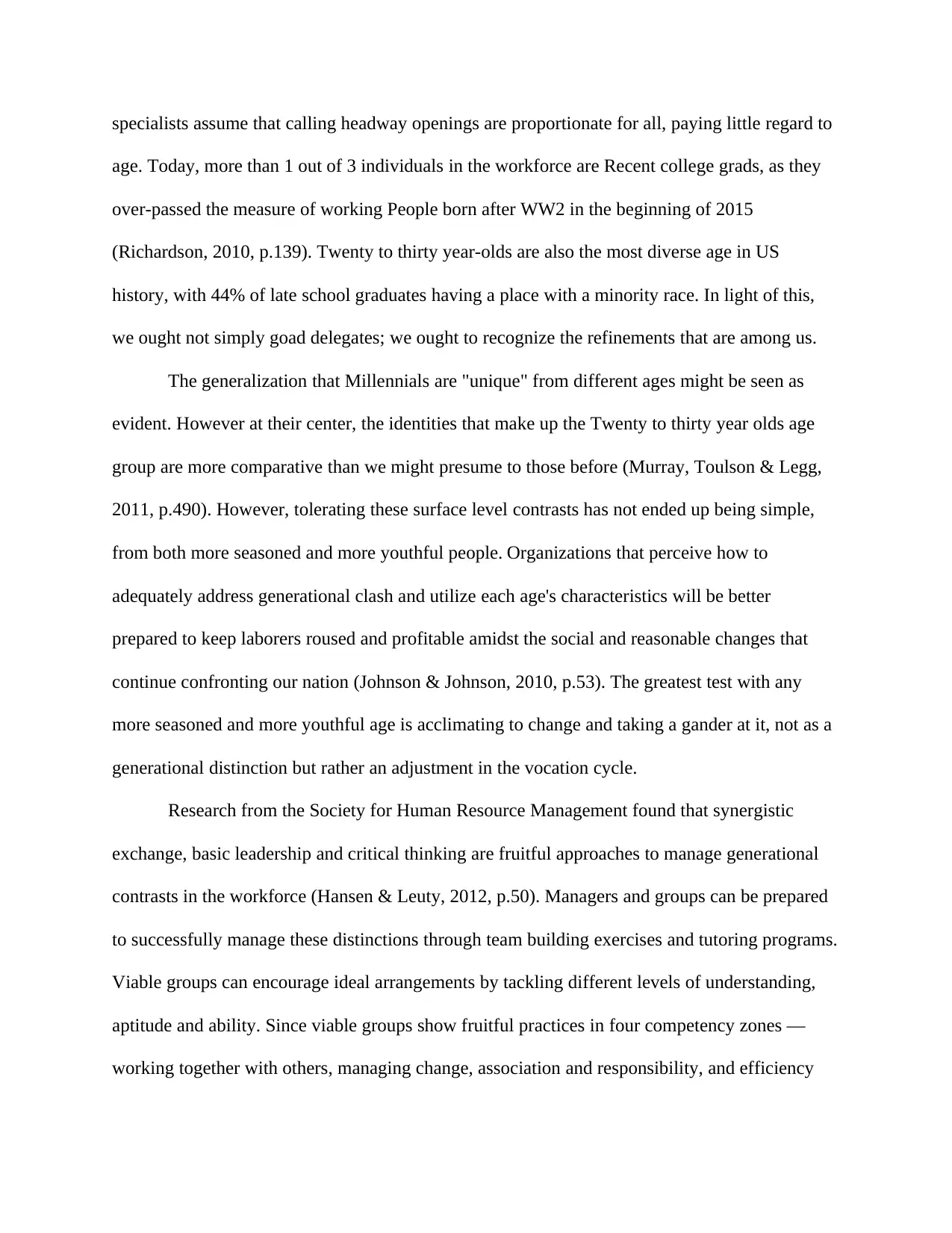
specialists assume that calling headway openings are proportionate for all, paying little regard to
age. Today, more than 1 out of 3 individuals in the workforce are Recent college grads, as they
over-passed the measure of working People born after WW2 in the beginning of 2015
(Richardson, 2010, p.139). Twenty to thirty year-olds are also the most diverse age in US
history, with 44% of late school graduates having a place with a minority race. In light of this,
we ought not simply goad delegates; we ought to recognize the refinements that are among us.
The generalization that Millennials are "unique" from different ages might be seen as
evident. However at their center, the identities that make up the Twenty to thirty year olds age
group are more comparative than we might presume to those before (Murray, Toulson & Legg,
2011, p.490). However, tolerating these surface level contrasts has not ended up being simple,
from both more seasoned and more youthful people. Organizations that perceive how to
adequately address generational clash and utilize each age's characteristics will be better
prepared to keep laborers roused and profitable amidst the social and reasonable changes that
continue confronting our nation (Johnson & Johnson, 2010, p.53). The greatest test with any
more seasoned and more youthful age is acclimating to change and taking a gander at it, not as a
generational distinction but rather an adjustment in the vocation cycle.
Research from the Society for Human Resource Management found that synergistic
exchange, basic leadership and critical thinking are fruitful approaches to manage generational
contrasts in the workforce (Hansen & Leuty, 2012, p.50). Managers and groups can be prepared
to successfully manage these distinctions through team building exercises and tutoring programs.
Viable groups can encourage ideal arrangements by tackling different levels of understanding,
aptitude and ability. Since viable groups show fruitful practices in four competency zones —
working together with others, managing change, association and responsibility, and efficiency
age. Today, more than 1 out of 3 individuals in the workforce are Recent college grads, as they
over-passed the measure of working People born after WW2 in the beginning of 2015
(Richardson, 2010, p.139). Twenty to thirty year-olds are also the most diverse age in US
history, with 44% of late school graduates having a place with a minority race. In light of this,
we ought not simply goad delegates; we ought to recognize the refinements that are among us.
The generalization that Millennials are "unique" from different ages might be seen as
evident. However at their center, the identities that make up the Twenty to thirty year olds age
group are more comparative than we might presume to those before (Murray, Toulson & Legg,
2011, p.490). However, tolerating these surface level contrasts has not ended up being simple,
from both more seasoned and more youthful people. Organizations that perceive how to
adequately address generational clash and utilize each age's characteristics will be better
prepared to keep laborers roused and profitable amidst the social and reasonable changes that
continue confronting our nation (Johnson & Johnson, 2010, p.53). The greatest test with any
more seasoned and more youthful age is acclimating to change and taking a gander at it, not as a
generational distinction but rather an adjustment in the vocation cycle.
Research from the Society for Human Resource Management found that synergistic
exchange, basic leadership and critical thinking are fruitful approaches to manage generational
contrasts in the workforce (Hansen & Leuty, 2012, p.50). Managers and groups can be prepared
to successfully manage these distinctions through team building exercises and tutoring programs.
Viable groups can encourage ideal arrangements by tackling different levels of understanding,
aptitude and ability. Since viable groups show fruitful practices in four competency zones —
working together with others, managing change, association and responsibility, and efficiency
Paraphrase This Document
Need a fresh take? Get an instant paraphrase of this document with our AI Paraphraser
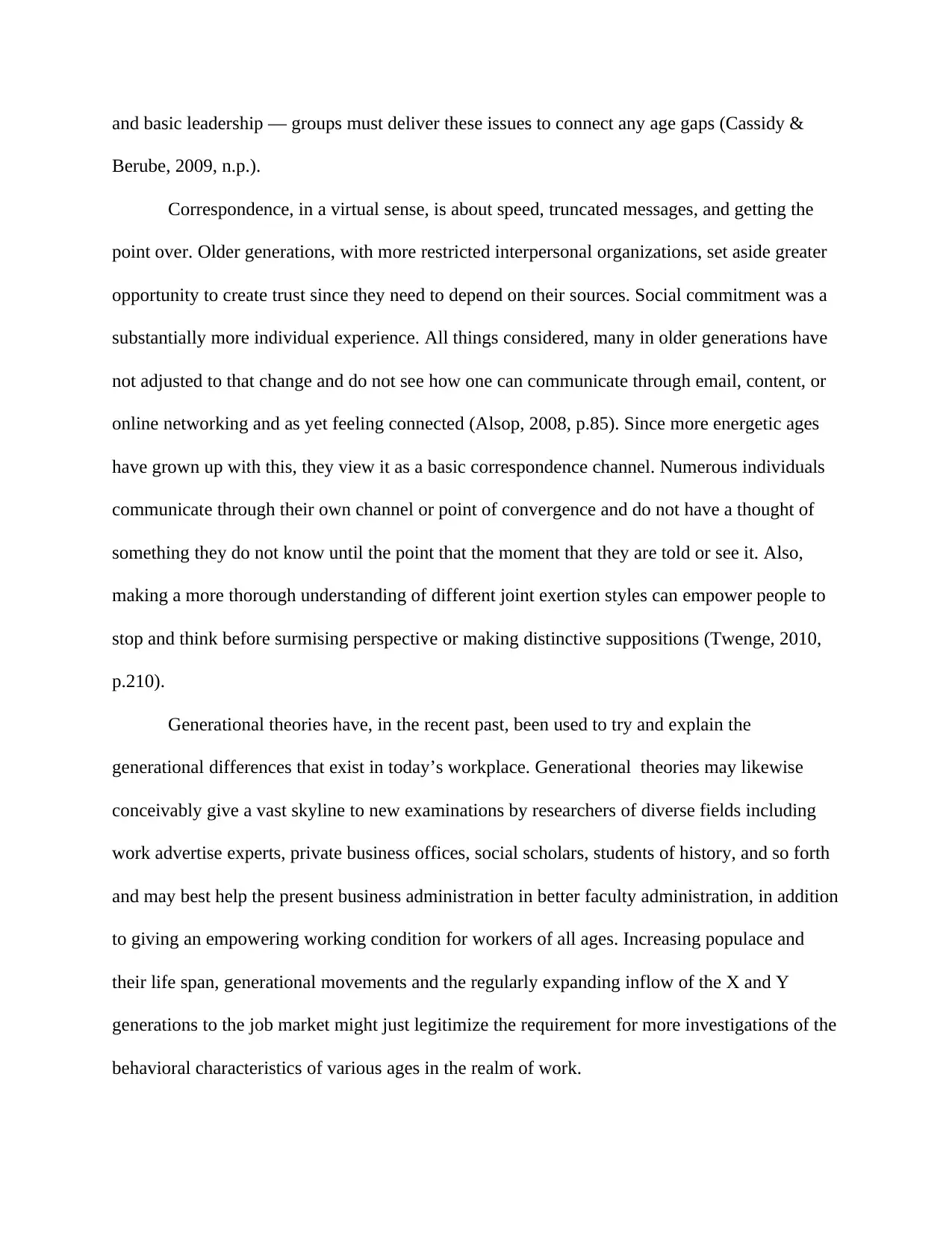
and basic leadership — groups must deliver these issues to connect any age gaps (Cassidy &
Berube, 2009, n.p.).
Correspondence, in a virtual sense, is about speed, truncated messages, and getting the
point over. Older generations, with more restricted interpersonal organizations, set aside greater
opportunity to create trust since they need to depend on their sources. Social commitment was a
substantially more individual experience. All things considered, many in older generations have
not adjusted to that change and do not see how one can communicate through email, content, or
online networking and as yet feeling connected (Alsop, 2008, p.85). Since more energetic ages
have grown up with this, they view it as a basic correspondence channel. Numerous individuals
communicate through their own channel or point of convergence and do not have a thought of
something they do not know until the point that the moment that they are told or see it. Also,
making a more thorough understanding of different joint exertion styles can empower people to
stop and think before surmising perspective or making distinctive suppositions (Twenge, 2010,
p.210).
Generational theories have, in the recent past, been used to try and explain the
generational differences that exist in today’s workplace. Generational theories may likewise
conceivably give a vast skyline to new examinations by researchers of diverse fields including
work advertise experts, private business offices, social scholars, students of history, and so forth
and may best help the present business administration in better faculty administration, in addition
to giving an empowering working condition for workers of all ages. Increasing populace and
their life span, generational movements and the regularly expanding inflow of the X and Y
generations to the job market might just legitimize the requirement for more investigations of the
behavioral characteristics of various ages in the realm of work.
Berube, 2009, n.p.).
Correspondence, in a virtual sense, is about speed, truncated messages, and getting the
point over. Older generations, with more restricted interpersonal organizations, set aside greater
opportunity to create trust since they need to depend on their sources. Social commitment was a
substantially more individual experience. All things considered, many in older generations have
not adjusted to that change and do not see how one can communicate through email, content, or
online networking and as yet feeling connected (Alsop, 2008, p.85). Since more energetic ages
have grown up with this, they view it as a basic correspondence channel. Numerous individuals
communicate through their own channel or point of convergence and do not have a thought of
something they do not know until the point that the moment that they are told or see it. Also,
making a more thorough understanding of different joint exertion styles can empower people to
stop and think before surmising perspective or making distinctive suppositions (Twenge, 2010,
p.210).
Generational theories have, in the recent past, been used to try and explain the
generational differences that exist in today’s workplace. Generational theories may likewise
conceivably give a vast skyline to new examinations by researchers of diverse fields including
work advertise experts, private business offices, social scholars, students of history, and so forth
and may best help the present business administration in better faculty administration, in addition
to giving an empowering working condition for workers of all ages. Increasing populace and
their life span, generational movements and the regularly expanding inflow of the X and Y
generations to the job market might just legitimize the requirement for more investigations of the
behavioral characteristics of various ages in the realm of work.
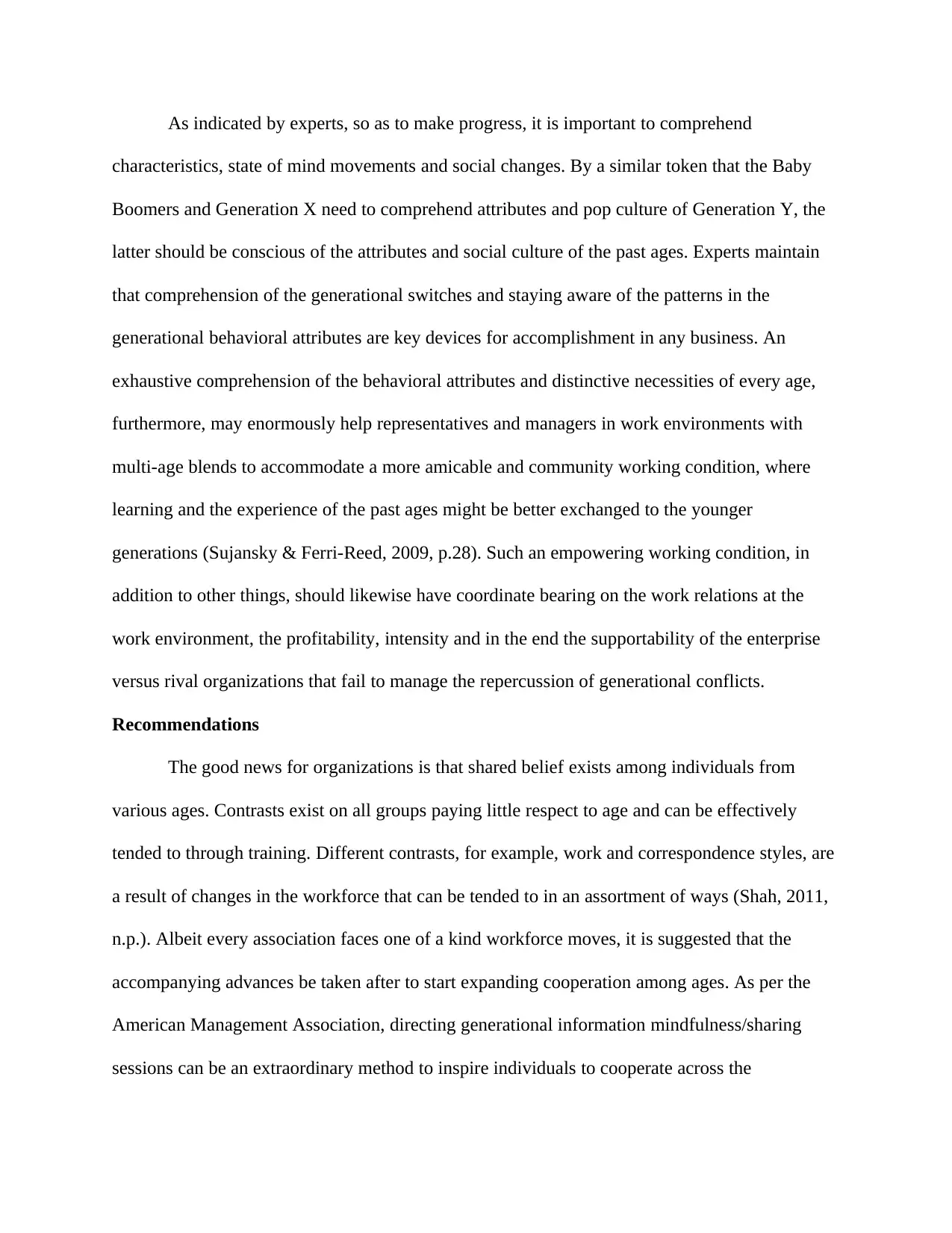
As indicated by experts, so as to make progress, it is important to comprehend
characteristics, state of mind movements and social changes. By a similar token that the Baby
Boomers and Generation X need to comprehend attributes and pop culture of Generation Y, the
latter should be conscious of the attributes and social culture of the past ages. Experts maintain
that comprehension of the generational switches and staying aware of the patterns in the
generational behavioral attributes are key devices for accomplishment in any business. An
exhaustive comprehension of the behavioral attributes and distinctive necessities of every age,
furthermore, may enormously help representatives and managers in work environments with
multi-age blends to accommodate a more amicable and community working condition, where
learning and the experience of the past ages might be better exchanged to the younger
generations (Sujansky & Ferri-Reed, 2009, p.28). Such an empowering working condition, in
addition to other things, should likewise have coordinate bearing on the work relations at the
work environment, the profitability, intensity and in the end the supportability of the enterprise
versus rival organizations that fail to manage the repercussion of generational conflicts.
Recommendations
The good news for organizations is that shared belief exists among individuals from
various ages. Contrasts exist on all groups paying little respect to age and can be effectively
tended to through training. Different contrasts, for example, work and correspondence styles, are
a result of changes in the workforce that can be tended to in an assortment of ways (Shah, 2011,
n.p.). Albeit every association faces one of a kind workforce moves, it is suggested that the
accompanying advances be taken after to start expanding cooperation among ages. As per the
American Management Association, directing generational information mindfulness/sharing
sessions can be an extraordinary method to inspire individuals to cooperate across the
characteristics, state of mind movements and social changes. By a similar token that the Baby
Boomers and Generation X need to comprehend attributes and pop culture of Generation Y, the
latter should be conscious of the attributes and social culture of the past ages. Experts maintain
that comprehension of the generational switches and staying aware of the patterns in the
generational behavioral attributes are key devices for accomplishment in any business. An
exhaustive comprehension of the behavioral attributes and distinctive necessities of every age,
furthermore, may enormously help representatives and managers in work environments with
multi-age blends to accommodate a more amicable and community working condition, where
learning and the experience of the past ages might be better exchanged to the younger
generations (Sujansky & Ferri-Reed, 2009, p.28). Such an empowering working condition, in
addition to other things, should likewise have coordinate bearing on the work relations at the
work environment, the profitability, intensity and in the end the supportability of the enterprise
versus rival organizations that fail to manage the repercussion of generational conflicts.
Recommendations
The good news for organizations is that shared belief exists among individuals from
various ages. Contrasts exist on all groups paying little respect to age and can be effectively
tended to through training. Different contrasts, for example, work and correspondence styles, are
a result of changes in the workforce that can be tended to in an assortment of ways (Shah, 2011,
n.p.). Albeit every association faces one of a kind workforce moves, it is suggested that the
accompanying advances be taken after to start expanding cooperation among ages. As per the
American Management Association, directing generational information mindfulness/sharing
sessions can be an extraordinary method to inspire individuals to cooperate across the
⊘ This is a preview!⊘
Do you want full access?
Subscribe today to unlock all pages.

Trusted by 1+ million students worldwide
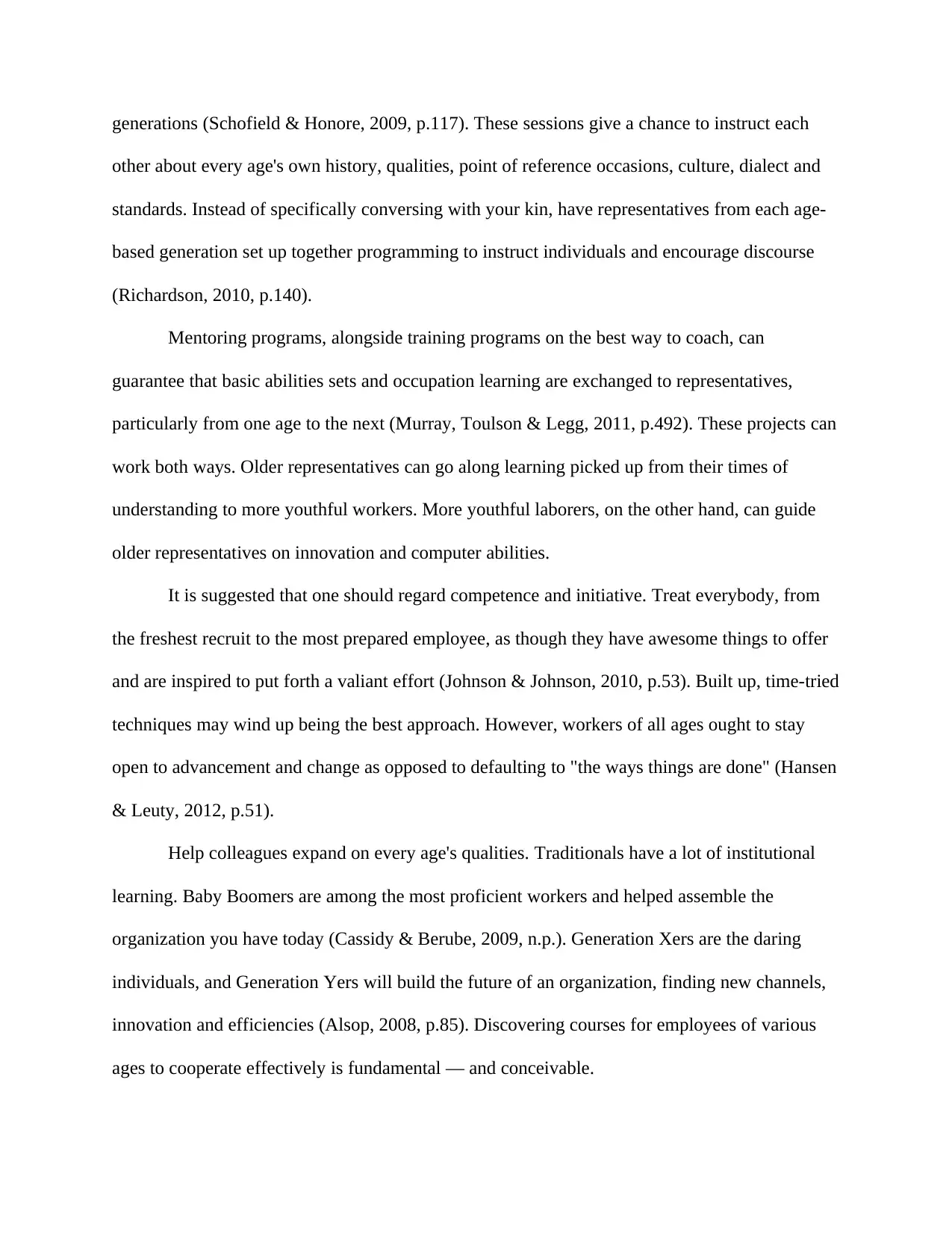
generations (Schofield & Honore, 2009, p.117). These sessions give a chance to instruct each
other about every age's own history, qualities, point of reference occasions, culture, dialect and
standards. Instead of specifically conversing with your kin, have representatives from each age-
based generation set up together programming to instruct individuals and encourage discourse
(Richardson, 2010, p.140).
Mentoring programs, alongside training programs on the best way to coach, can
guarantee that basic abilities sets and occupation learning are exchanged to representatives,
particularly from one age to the next (Murray, Toulson & Legg, 2011, p.492). These projects can
work both ways. Older representatives can go along learning picked up from their times of
understanding to more youthful workers. More youthful laborers, on the other hand, can guide
older representatives on innovation and computer abilities.
It is suggested that one should regard competence and initiative. Treat everybody, from
the freshest recruit to the most prepared employee, as though they have awesome things to offer
and are inspired to put forth a valiant effort (Johnson & Johnson, 2010, p.53). Built up, time-tried
techniques may wind up being the best approach. However, workers of all ages ought to stay
open to advancement and change as opposed to defaulting to "the ways things are done" (Hansen
& Leuty, 2012, p.51).
Help colleagues expand on every age's qualities. Traditionals have a lot of institutional
learning. Baby Boomers are among the most proficient workers and helped assemble the
organization you have today (Cassidy & Berube, 2009, n.p.). Generation Xers are the daring
individuals, and Generation Yers will build the future of an organization, finding new channels,
innovation and efficiencies (Alsop, 2008, p.85). Discovering courses for employees of various
ages to cooperate effectively is fundamental — and conceivable.
other about every age's own history, qualities, point of reference occasions, culture, dialect and
standards. Instead of specifically conversing with your kin, have representatives from each age-
based generation set up together programming to instruct individuals and encourage discourse
(Richardson, 2010, p.140).
Mentoring programs, alongside training programs on the best way to coach, can
guarantee that basic abilities sets and occupation learning are exchanged to representatives,
particularly from one age to the next (Murray, Toulson & Legg, 2011, p.492). These projects can
work both ways. Older representatives can go along learning picked up from their times of
understanding to more youthful workers. More youthful laborers, on the other hand, can guide
older representatives on innovation and computer abilities.
It is suggested that one should regard competence and initiative. Treat everybody, from
the freshest recruit to the most prepared employee, as though they have awesome things to offer
and are inspired to put forth a valiant effort (Johnson & Johnson, 2010, p.53). Built up, time-tried
techniques may wind up being the best approach. However, workers of all ages ought to stay
open to advancement and change as opposed to defaulting to "the ways things are done" (Hansen
& Leuty, 2012, p.51).
Help colleagues expand on every age's qualities. Traditionals have a lot of institutional
learning. Baby Boomers are among the most proficient workers and helped assemble the
organization you have today (Cassidy & Berube, 2009, n.p.). Generation Xers are the daring
individuals, and Generation Yers will build the future of an organization, finding new channels,
innovation and efficiencies (Alsop, 2008, p.85). Discovering courses for employees of various
ages to cooperate effectively is fundamental — and conceivable.
Paraphrase This Document
Need a fresh take? Get an instant paraphrase of this document with our AI Paraphraser
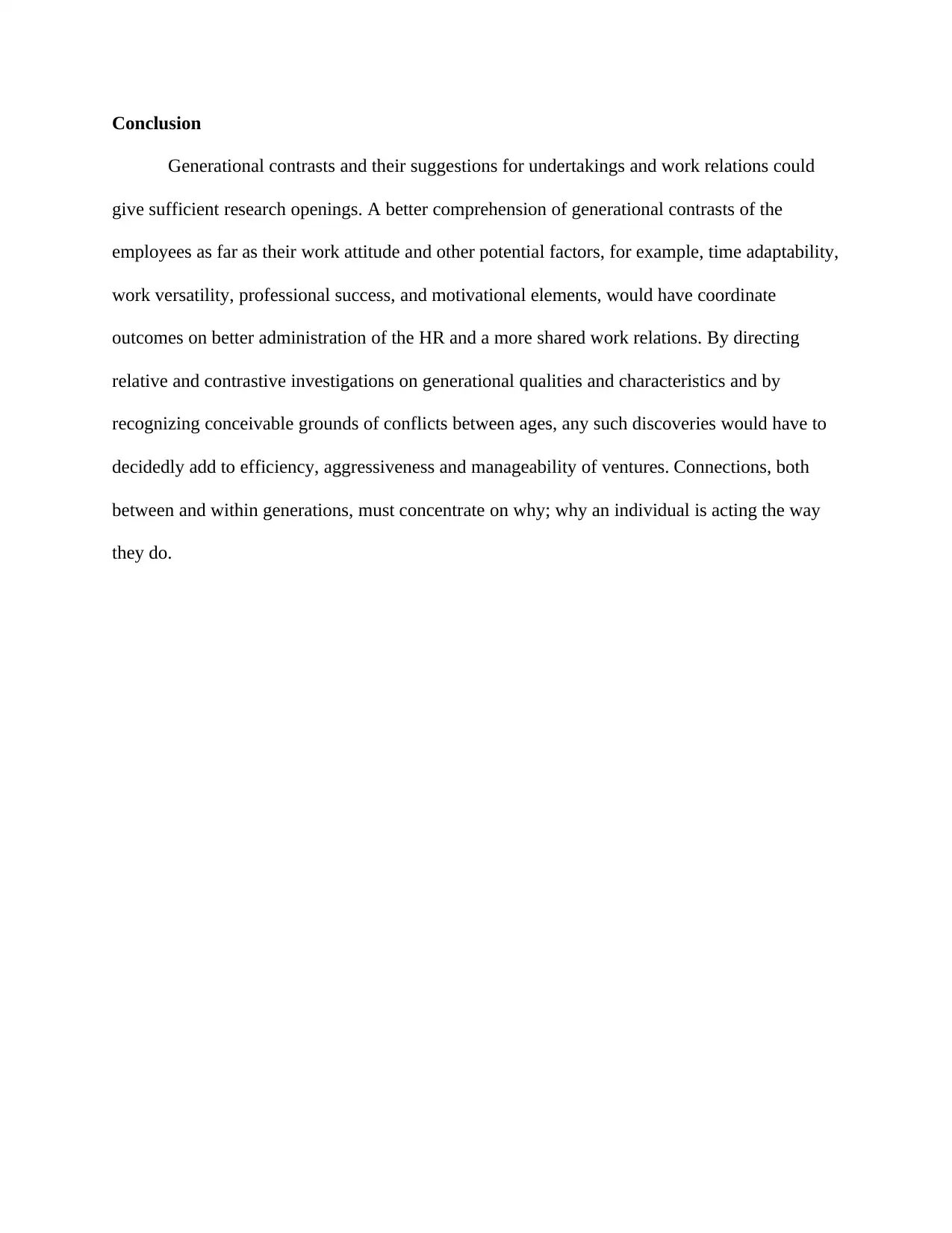
Conclusion
Generational contrasts and their suggestions for undertakings and work relations could
give sufficient research openings. A better comprehension of generational contrasts of the
employees as far as their work attitude and other potential factors, for example, time adaptability,
work versatility, professional success, and motivational elements, would have coordinate
outcomes on better administration of the HR and a more shared work relations. By directing
relative and contrastive investigations on generational qualities and characteristics and by
recognizing conceivable grounds of conflicts between ages, any such discoveries would have to
decidedly add to efficiency, aggressiveness and manageability of ventures. Connections, both
between and within generations, must concentrate on why; why an individual is acting the way
they do.
Generational contrasts and their suggestions for undertakings and work relations could
give sufficient research openings. A better comprehension of generational contrasts of the
employees as far as their work attitude and other potential factors, for example, time adaptability,
work versatility, professional success, and motivational elements, would have coordinate
outcomes on better administration of the HR and a more shared work relations. By directing
relative and contrastive investigations on generational qualities and characteristics and by
recognizing conceivable grounds of conflicts between ages, any such discoveries would have to
decidedly add to efficiency, aggressiveness and manageability of ventures. Connections, both
between and within generations, must concentrate on why; why an individual is acting the way
they do.
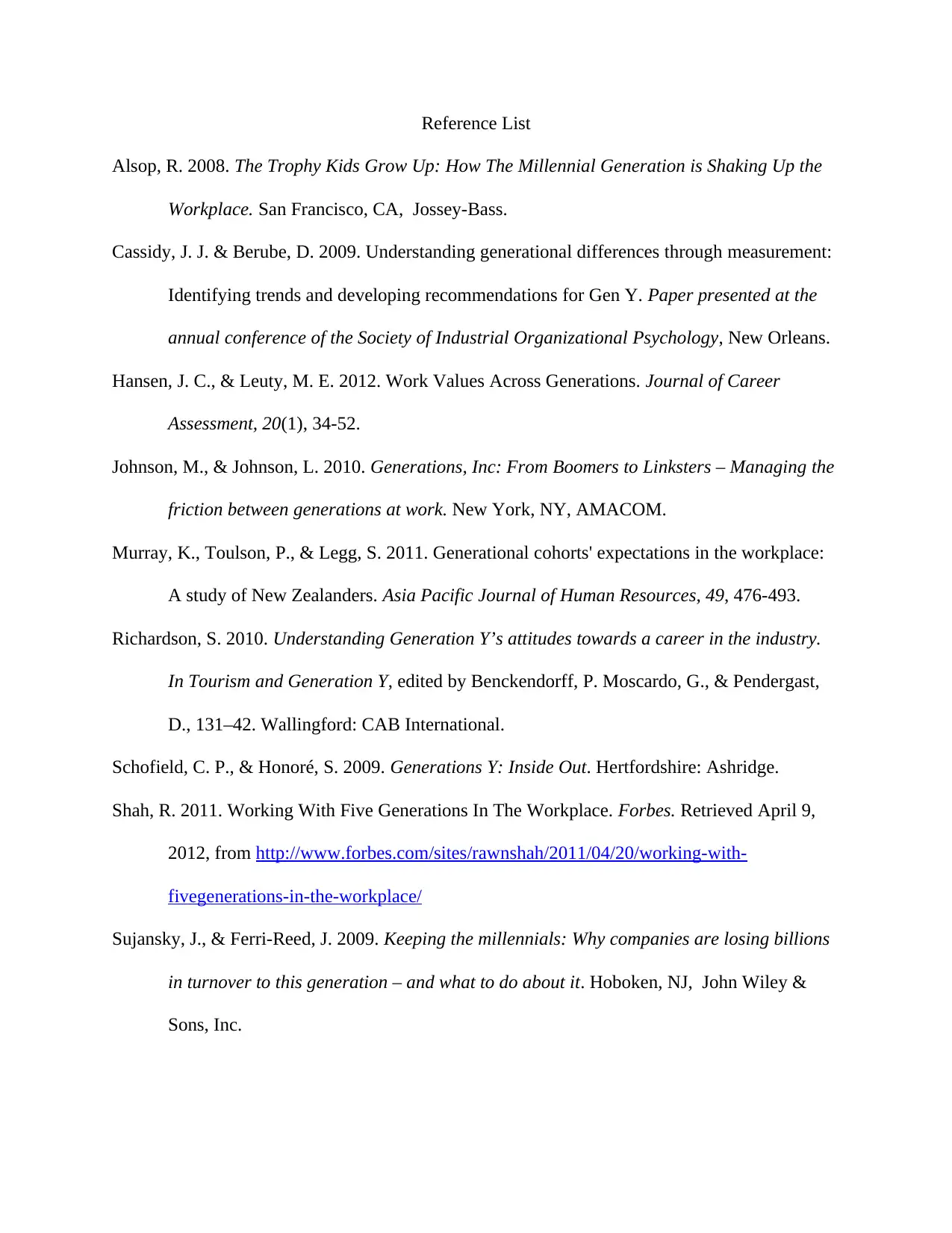
Reference List
Alsop, R. 2008. The Trophy Kids Grow Up: How The Millennial Generation is Shaking Up the
Workplace. San Francisco, CA, Jossey-Bass.
Cassidy, J. J. & Berube, D. 2009. Understanding generational differences through measurement:
Identifying trends and developing recommendations for Gen Y. Paper presented at the
annual conference of the Society of Industrial Organizational Psychology, New Orleans.
Hansen, J. C., & Leuty, M. E. 2012. Work Values Across Generations. Journal of Career
Assessment, 20(1), 34-52.
Johnson, M., & Johnson, L. 2010. Generations, Inc: From Boomers to Linksters – Managing the
friction between generations at work. New York, NY, AMACOM.
Murray, K., Toulson, P., & Legg, S. 2011. Generational cohorts' expectations in the workplace:
A study of New Zealanders. Asia Pacific Journal of Human Resources, 49, 476-493.
Richardson, S. 2010. Understanding Generation Y’s attitudes towards a career in the industry.
In Tourism and Generation Y, edited by Benckendorff, P. Moscardo, G., & Pendergast,
D., 131–42. Wallingford: CAB International.
Schofield, C. P., & Honoré, S. 2009. Generations Y: Inside Out. Hertfordshire: Ashridge.
Shah, R. 2011. Working With Five Generations In The Workplace. Forbes. Retrieved April 9,
2012, from http://www.forbes.com/sites/rawnshah/2011/04/20/working-with-
fivegenerations-in-the-workplace/
Sujansky, J., & Ferri-Reed, J. 2009. Keeping the millennials: Why companies are losing billions
in turnover to this generation – and what to do about it. Hoboken, NJ, John Wiley &
Sons, Inc.
Alsop, R. 2008. The Trophy Kids Grow Up: How The Millennial Generation is Shaking Up the
Workplace. San Francisco, CA, Jossey-Bass.
Cassidy, J. J. & Berube, D. 2009. Understanding generational differences through measurement:
Identifying trends and developing recommendations for Gen Y. Paper presented at the
annual conference of the Society of Industrial Organizational Psychology, New Orleans.
Hansen, J. C., & Leuty, M. E. 2012. Work Values Across Generations. Journal of Career
Assessment, 20(1), 34-52.
Johnson, M., & Johnson, L. 2010. Generations, Inc: From Boomers to Linksters – Managing the
friction between generations at work. New York, NY, AMACOM.
Murray, K., Toulson, P., & Legg, S. 2011. Generational cohorts' expectations in the workplace:
A study of New Zealanders. Asia Pacific Journal of Human Resources, 49, 476-493.
Richardson, S. 2010. Understanding Generation Y’s attitudes towards a career in the industry.
In Tourism and Generation Y, edited by Benckendorff, P. Moscardo, G., & Pendergast,
D., 131–42. Wallingford: CAB International.
Schofield, C. P., & Honoré, S. 2009. Generations Y: Inside Out. Hertfordshire: Ashridge.
Shah, R. 2011. Working With Five Generations In The Workplace. Forbes. Retrieved April 9,
2012, from http://www.forbes.com/sites/rawnshah/2011/04/20/working-with-
fivegenerations-in-the-workplace/
Sujansky, J., & Ferri-Reed, J. 2009. Keeping the millennials: Why companies are losing billions
in turnover to this generation – and what to do about it. Hoboken, NJ, John Wiley &
Sons, Inc.
⊘ This is a preview!⊘
Do you want full access?
Subscribe today to unlock all pages.

Trusted by 1+ million students worldwide
1 out of 13
Your All-in-One AI-Powered Toolkit for Academic Success.
+13062052269
info@desklib.com
Available 24*7 on WhatsApp / Email
![[object Object]](/_next/static/media/star-bottom.7253800d.svg)
Unlock your academic potential
Copyright © 2020–2025 A2Z Services. All Rights Reserved. Developed and managed by ZUCOL.